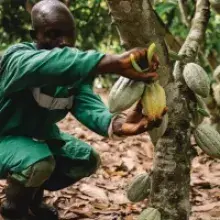SHERIDAN, WYOMING – August 26, 2025 – Chocolate lovers may soon enjoy their favorite treat knowing it’s not only delicious but also kinder to the planet. Nestlé has unveiled a pioneering technique that uses up to 30% more of the cocoa fruit, transforming the way chocolate is made and giving farmers a better yield from every harvest.
Making Chocolate Smarter, Not Just Sweeter
Traditionally, only the cocoa beans inside the pod make it into chocolate, while much of the fruit — pulp, placenta, and husk — goes unused. Nestlé’s scientists asked a simple but powerful question: what if nothing went to waste? Their answer is a patented process that collects everything inside the pod as a wet mass, naturally ferments it to unlock flavor, and then transforms it into chocolate flakes ready for production.
This method could be a game-changer not just for manufacturers, but also for consumers who increasingly seek sustainable products without sacrificing taste.
Why This Matters for Farmers and Consumers
By making better use of the cocoa fruit, farmers can increase the material they sell without planting more trees — a crucial step in a world where climate change is already threatening crop yields. Louise Barrett, Head of the Nestlé Research and Development Center for Confectionery in York, UK, explains: "With climate change increasingly affecting cocoa yields around the world, we are exploring innovative solutions that could help cocoa farmers maximize the potential of their harvests. This groundbreaking technique utilizes more of the fruit, while enabling us to provide delicious chocolate to our consumers. While this project is still at a pilot stage, we are currently exploring how to apply this innovation at a larger scale."
For consumers, that means enjoying the same creamy, rich chocolate experience with the added satisfaction of knowing it supports more efficient and sustainable farming.
A Step Toward More Sustainable Chocolate
Cocoa farming is labor-intensive, and time is often stretched thin. Nestlé’s approach could free up valuable hours for farmers by streamlining cocoa extraction. That extra time can be reinvested in important agricultural practices like pruning, which has been proven to improve yields over time.
The ripple effects are significant:
- Less waste: Up to 30% more of each cocoa pod gets used.
- More yield: Farmers gain additional material to sell without extra land.
- Time savings: Simpler processing gives farmers space to focus on long-term practices.
- Sustainability: Reduced waste aligns with growing global demand for eco-friendly food.
How It Stacks Up Against Traditional Chocolate
Think of it as an evolution in chocolate making. While the taste remains the same, the process is leaner, greener, and smarter:
- Traditional method: Uses only beans, discards pulp and husk, requires multiple steps.
- Nestlé’s new method: Uses whole pod mass, ferments naturally, simplifies production.
It’s similar to how nose-to-tail dining in restaurants minimizes food waste — except here, it’s “pod-to-bar” chocolate.
Quick FAQ: What You Need to Know
Will it taste different?
No — Nestlé emphasizes that the chocolate flavor is preserved, delivering the same taste people know and love.
Is it already in stores?
Not yet. The project is still in the pilot stage, but scaling plans are underway.
What’s in it for consumers?
Peace of mind. Every bite supports smarter farming, reduced waste, and a more sustainable chocolate industry.
A Sweeter Future on the Horizon
Nestlé’s cocoa innovation is about more than chocolate bars. It’s about rethinking how food is produced in a resource-stretched world. For everyday chocolate lovers, it’s a simple but powerful shift — the joy of indulgence paired with the reassurance that every pod is used wisely.
Learn more at Nestlé.com.
